|
Over two years have passed since the introduction
of Reefkeeping.com, which from the beginning included the
regular monthly column "Fish Tales." Recently, I
came to realize that neither the guest columnists nor I have
done a column on a group of marine fish that is very popular
among hobbyists worldwide. With this in mind I decided not
only to focus the June column on Blennioids, but to feature
this family's most species-rich genus. Although most members
of Blenniidae have a rather bland coloration, and have looks
described as "a face only a mother could love;"
all members have "personality." It is this trait
that makes them so popular to aquarists. The fact that Ecsenius
species are, however, the most attractive looking group of
the family, and the particular genus that I choose to focus
on this month, is no coincidence. Without a doubt, the beauty
of some Ecsenius species rivals the most attractive
marine fish. Without further ado, let's take a look at one
genus of the Comb-toothed blennies.
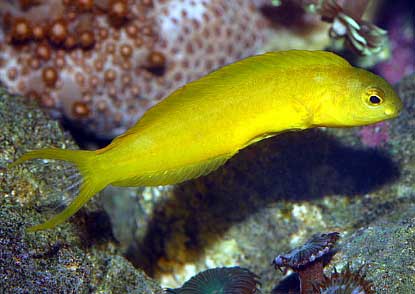 |
|
Meiacanthus ovalaunensis is nearly identical
to Ecsenius midas, but the well-trained eye can
pick out the different head and jaw structure between
the two species. Additionally, E. midas will
generally have thin blue stripes around their eyes or
lower jaw. Photo courtesy of Greg Rothschild.
|
Meet the Family
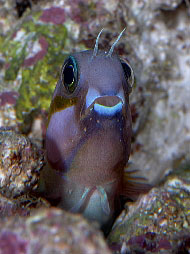 |
|
Photo
courtesy of Greg Rothschild.
|
Blennies have been divided into four families:
Blenniidae, Chaenopsidae, Clinidae, and Labrisomidae. The
Comb-toothed blennies are from the family Blenniidae, which
is the largest of the four families and is rather diverse,
consisting of six tribes, 53 genera and roughly 350 species.
The vast majority of these blennies lack a swim bladder (although
Aspidontus, Meiacanthus, Petroscirtes,
and Plagiotremus all have a small swim bladder), which
results in the fish lying or resting on coral, rock, substrate,
and even the sides of the aquarium. Some members of this family
are considered mimics of poisonous fish, while other members
are quite poisonous themselves. Finally, all family members
lack scales.
The 51 members (see below) are awarded
such status only if they have both an anterior and posterior
canine tooth. No other members of the tribe Salarini have
these specific teeth, although most members of the tribe Parablenniini
do. In the case of Ecsenius, the anterior canines are
so similar to the incisors that in many cases those teeth
cannot be differentiated except by scientific osteological
preparations. Finally, the presence of the teeth "indicates
that Ecsenius is the sister group of all Salarinni
and that it is plesiomorphic for anterior canines" (Springer,
1988).
| §
aequalis |
§
alleni |
| §
aroni |
| §
australianus |
| §
axelrodi |
| §
bandanus |
| §
bathi |
| §
bicolor |
| §
bimaculatus |
| §
collettei |
| §
dentex |
| §
dilemma |
| §
fijiensis |
| §
fourmanoiri |
| §
frontalis |
| §
gravieri |
| §
isos |
| §
kurti |
| §
lineatus |
| §
lividanalis |
| §
lubbocki |
| §
mandibularis |
| §
melarchus |
| §
midas |
| §
minutus |
|
| §
monoculus |
§
nalolo |
| §
namiyei |
| §
niue |
| §
oculatus |
| §
oculus |
| §
ops |
| §
opsifrontalis |
| §
pardus |
| §
paroculus |
| §
pictus |
| §
polystictus |
| §
portenoyi |
| §
prooculis |
| §
pulcher |
| §
randalli |
| §
schroederi |
| §
sellifer |
| §
stictus |
| §
stigmatura |
| §
taeniatus |
| §
tessera |
| §
tigris |
| §
tricolor |
| §
trilineatus |
| §
yaeyamaensis |
|
|
Additionally, males and many females have
elongated upper and/or lower caudal lobes; no other Salariini
nor Blenniini possess this feature. Also, Ecsenius
lacks circumorbital bones, whereas all other members of Blennidae
have four circumorbital bones. Finally, except for a few members
of Nemophidinae, only Ecsenius have their lateral
extrascapular bones fused with the pterotics.
|
Ecsenius bimaculatus is one of the smallest members
of Ecsenius. The largest female collected has
been 27 mm, while the largest male was 32 mm. Although
this species is uncommon in the wild, the natural range
found only within the Philippine Islands makes it available
within the hobby on occasion. Photo courtesy of Jack
Randall (left) and Darren Hoglund (right).
|
Although one subgenus was used in the past to help differentiate
Ecsenius midas from all other members of the Ecsenius
genus, this subgenus, Antiblennini is no longer in
use. Springer (1988) recognized the lack of "obvious
synamorphy which defined all other species of Ecsenius
to the exclusion of Ecsenius midas." As such he
felt no less than two additional subgenera would be required
to maintain nomenclatural consistency, so until further research
was able to form better interrelationships within the genus,
the best move was to reconsider his earlier notion of E.
midas being a monotypic subgenus and thus Ecsenius
currently is not subdivided into subgenera.
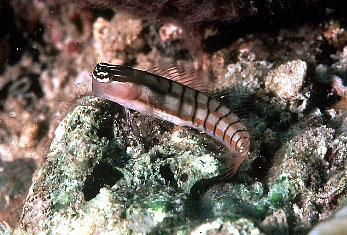 |
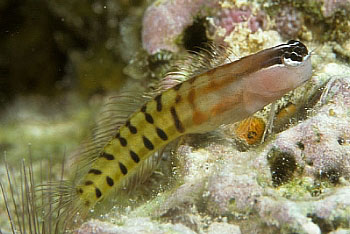 |
Left: Ecsenius dilemma is noted to have two
distinct color patterns. The banded color form, as seen above,
is considerably more common than the striped version. This
species is nearly identical to E. bathi. Right:
As an endemic of the Fiji Islands, Ecsenius fijiensis
is usually found deeper than 30 feet, although it has occasionally
been found as shallow as one foot or as deep as 100 feet.
Photos courtesy of John Randall.
In an attempt to organize Ecsenius species into groups
that contain species that are somewhat similar, 12 groups
have been recognized and the species spilt up accordingly
(see below). The Pulcher Group, consisting
of three species, all have 13 dorsal fin spines, 14 pectoral
fin rays, and 11 precaudal vertebrae. The Stigmatura Group
maintains four species which all have a black spot behind
the anus. Frontalis is recognized as the lone species in this
group, one of three groups with only one member, because they
have the highest number of pectoral fin rays at 15. The Yaeyamaensis
Group is divided based solely on color patterns that exist
on the jaw-line, head, and the base of the pectoral fins.
Pink or orange stripes are indicative of the nine species
of the Opsifrontalis Group. Pictus and Lineatus, the remaining
two groups comprised of only a single species, are recognized
as such because of their unique coloration. The four members
of Mandibularis all have a high number of canine teeth. Whereas
all other species have one or two posterior canines, the Mandibularis
members have between four and eight canines. Besides being
the smallest members of the genus, the Prooculis Group has
a distinctive sexual dimorphism, with dark crescent shapes
on the head of males, and pale crescent shapes on the females.
Cirri both anterior and posterior to the anterior nostril
are what separate the two species of the Bicolor Group from
all others, which have cirri only posterior to the anterior
nostril. The final group of eight species,
Oculus, was at one time recognized as a single species. Like
several other groups, these members share a unique color pattern
unto themselves - a snow white spot next to the pectoral fin's
axil (Springer, 1971; 1976; 1988).
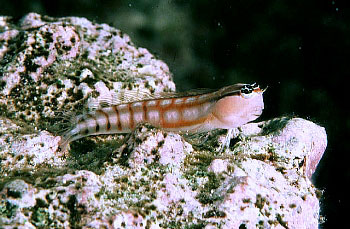 |
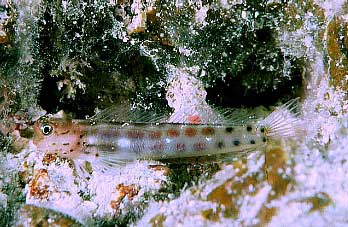 |
Left: Ecsenius opsofrontalis has the largest
distribution of any species from the Opsofrontalis Group.
This particular photograph shows one of at least four different
color variations. Right: The namesake of the Isos group,
Ecsenius isos, clearly shows in the photo above the
typical dark spots which are found on both the male and females
of the Isos Group (as opposed to the males only in Prooculis).
Photos courtesy of John Randall.
|
Pulcher
|
Stigmatura
|
Frontalis
|
Bicolor
|
Lineatus
|
Pictus
|
|
aroni
|
lividanalis
|
frontalis
|
bicolor
|
lineatus
|
pictus
|
|
gravieri
|
melarchus
|
|
namiyei
|
|
|
|
pulcher
|
midas
|
|
|
|
|
|
|
stigmatura
|
|
|
|
|
|
Oculus
|
Yaeyamaensis
|
Opsifrontalis
|
Isos
|
Prooculis
|
Mandibularis
|
|
monoculus
|
dentex
|
alleni
|
isos
|
bandanus
|
mandibularis
|
|
oculatus
|
minutus
|
australianus
|
lubbocki
|
bimaculatus
|
schroederi
|
|
oculus
|
nalolo
|
axelrodi
|
trilineatus
|
collettei
|
aequalis
|
|
pardus
|
stictus
|
bathi
|
|
prooculis
|
kurti
|
|
paroculus
|
yaeyamaensis
|
dilemma
|
|
taeniatus
|
|
|
portenoyi
|
|
fijiensis
|
|
|
|
|
sellifer
|
|
fourmanoiri
|
|
|
|
|
tessera
|
|
niue
|
|
|
|
|
|
|
opsifrontalis
|
|
|
|
|
|
|
tigris
|
|
|
|
Although currently recognized as a member of the Opsifrontalis
Group, this group may
be split into two parts and Ecsenius tigris may be
moved into the new group containing
E. fijiensis since these are the only two Opsifrontalis
members with a single color pattern.
Photo courtesy of John Randall.
In the Wild
Comb-toothed blennies are located throughout
most of the Indo-Pacific region, but do not extend into the
eastern Pacific. The overall range of the genus is best defined
as the eastern coast of Africa as far east as the Tongan Islands,
and from Ryukyu Islands north of Japan to as far south as
the southern edge of the Great Barrier Reef. Despite a single
report of E. bicolor from Hawaii, no species are currently
recognized as present in the Hawaiian Islands. Ecsenius
frontalis and E. pulcher can both be found in only
the Red Sea and the Persian Gulf, which typifies the localized
distribution of species in this genus. In fact, the limited
distribution seems to have baffled researchers, as the planktonic
stage should support a wider distribution than it currently
does. Springer (1988) believes the cause of the limited distribution
lies in the tectonic history of the Indo-Pacific region.
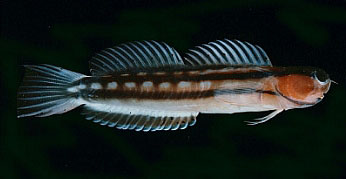 |
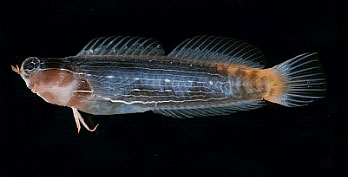 |
Left: A photograph of a freshly killed Ecsenius
fourmanoiri shows the coloration that is typical of the
Opsifrontalis Group. Ecsenius australianus is nearly
identical in coloration to E. fourmanoiri. Right:
As one of the deep water dwelling species, Ecsenius pictus
has never been recorded in less than 30 feet of water. As
they are only known from the Philippine Islands, they may
occasionally show up in the aquarium trade. The photo above
is of a freshly killed individual. Photos courtesy of John
Randall.
If corals are not present, neither are Ecsenius species.
The distribution of comb-toothed blennies is correlated directly
with areas of dense coral growth. This includes the surge
zone, quiet lagoons, and even the tidal pools, provided dense
coral growth is plentiful. They are generally found at shallow
depths, sometimes as shallow as a couple of feet, but some
species may on occasion be found at depths below 120 feet.
They are not, however, located along shorelines, even if corals
are present. Most individuals have a limited range of motion,
rarely moving more than several feet in any direction. These
blennies will "hole-up" in small crevices and are
virtually impossible to evict from their quarters once they
are within it. Under close observation even considerably larger
individuals were unable to launch an effective offensive attack
against a smaller fish already in a hole. Additionally, these
fish are non-violent and will generally retreat into a small
crevice if threatened.
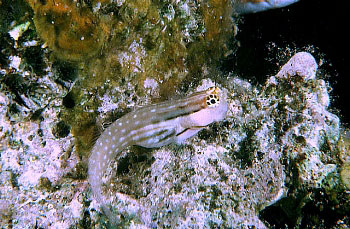 |
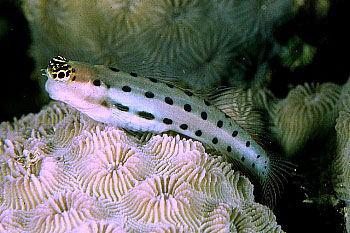 |
Left: Although named Ecsenius nalolo
in 1959, in 1971 it was synonymized with E. minutus.
In 1988 Springer reassessed his earlier assertion and once
again recognized E. nalolo as a valid species. Right:
The vivd coloration of Ecsenius collettei sets itself
apart from any other Ecsenius species. Only eight specimens
have ever been recorded, all from Krankett Island, Papue-New
Guinea. Photos courtesy of John Randall.
Ecsenius species hatch into life at roughly 3.5 mm
of total length and by the time they reach 12 mm they are
nearly identical to adults in color and morphology. Little
else is known about the reproductive habits or impending fry
development of this genus. What is well documented, however,
is the sexual dimorphism that is present amongst genus members.
Although several variations exist, and vary depending on the
species, all Ecsenius share the common Blenniid traits
of a greatly reduced first dorsal spine for females, as well
as a triangular fleshy lobe encompassing the large urogenital
opening, while males have a small opening at the end of the
small tube. Males are likely to attain a larger adult size
than the females. For instance, the largest E. bicolor
male collected measured 77 mm, while the largest female was
only 59 mm. Further, of individuals measuring more than 24
mm, 40 of 128 males exceeded 55 mm, compared to only two of
110 females. Males develop thick fleshy tips on the ends of
their anal rays and have longer caudal fins than equally sized
females. Additionally, some species' females (E. bicolor,
E. nalolo) have significantly more teeth than males.
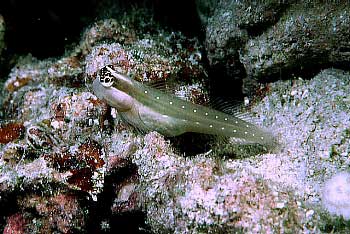 |
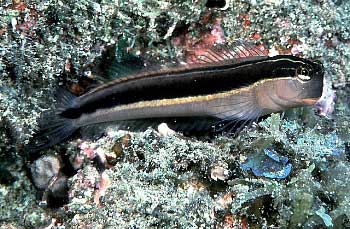 |
Left: Restricted to the reefs off the coast
of Queensland, Australia is Ecsenius mandibularis.
A somewhat bland coloration and limited distribution makes
for an unlikely aquarium acquisition. Right: Ecsenius
lineatus has a peculiar distribution in the wild. Individuals
from the northern edge of their natural range are noted to
occur most frequently in less than several feet of water,
whereas individuals from the southern edge of their natural
distribution are noted to occur commonly past 20 feet of water
and are sometimes noted in as much as 80 feet of water. Photos
courtesy of John Randall.
The best defense of most members of Ecsenius is limited
to "holing up" in small crevices. Certain members
of the genus, however, are known to mimic various other fish,
which is likely a better defensive mechanism, at least for
them. Ecsenius bicolor was once thought to mimic the
poisonous fang-toothed blenny Meiacanthus atrodoralis
not only in color at depth but also in morphology (Springer,
1971). However, further research by Springer (1988) prompted
him to exclude Ecsenius bicolor from mimetic relationships
mainly because color variations within the two species were
not consistent from one location to the next. Ecsenius
gravieri mimics M. nigrolineatus, another fang-toothed
blenny. Further mimicry is said to exist between E. midas
and the anthiine Anthias squamipinnis. This is, however,
loosely based on the fact that E. midas is noted to
hover in dense schools of A. squamipinnis. This situation
could simply be safety in numbers, rather than mimicry (Springer,
1971).
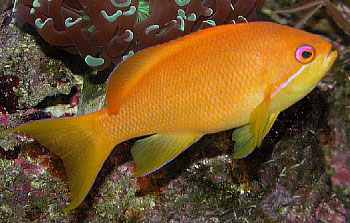 |
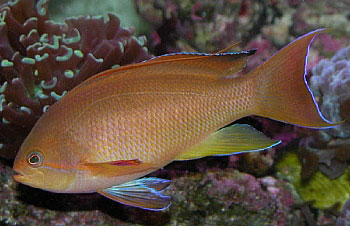 |
Psuedanthias squamipinnis most likely provides protection
to Ecsenius midas due to the overwhelming numbers in
a school (protection in numbers) of the Anthiids and E.
midas is probably not a mimic of this species like Starck
(1969) proposed. Photos by Henry C. Schultz III.
Photos courtesy of Robie Sayan (ROBZ) above and Greg
Rothschild below.
In the Home Aquarium
Without a doubt, Ecsenius species
can do well in home aquaria provided the proper precautions
are taken before their introduction into the aquarium. Although
many species can be considered perfect reef aquarium fish,
other species or even other individuals of "safe"
species may begin to nip at clam mantles, LPS polyps, or to
scrape SPS tissue. It has been hypothesized that they are
capable of utilizing the symbiotic algae that reside within
these tissues. Much like dwarf angelfish are "hit-n-miss"
for reef aquarium suitability, so are Ecsenius blennies.
Be forewarned - it is not easy to remove these small fish
once they are in the aquarium. Possibly the best option is
removing the entire rock in which the blenny has decided to
hide out. Once high and dry they have a tendency to jump clear
of the rock. If you are not careful they will land back in
your aquarium.
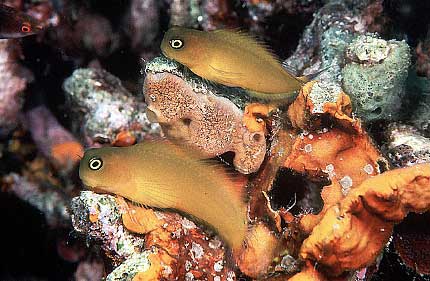 |
|
A pair of Ecsenius lividanalis sit side-by-side
in the wild. This is one of five species that also has
a bi-colored color pattern. Pay close attention to the
spelling as this species was scientifically misspelled
for nearly 20 years. Photo courtesy of John Randall.
|
With large individuals stretching the measuring tape to a
whole ten centimeters, and with the tendency of these fish
not to roam great distances, they make ideal additions to
smaller aquariums. A single specimen will generally do well
in aquariums of 30 gallons or larger. If you wish to find
a male/female pair, be sure to carefully use the characteristics
laid out here to discern sexes, and provide, as a minimum,
a 75 gallon aquarium for your pair. If two males are added
to the same aquarium, it is likely one will perish. Mixing
species is not recommended because, once again, they will
generally not coexist and the weaker of the two will be eliminated.
|
|
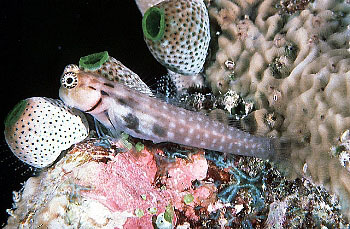 |
|
Above: Some specimens of Ecsenius melarchus
do not have the bright blue on the head as seen in this
photo. In those individuals, the white portion of the
lower half of the body extends all the way up the head.
Photo courtesy of John Randall.
|
Above:
Known only from the Maldives Islands, Ecsenius minutus
is not likely to appear in the aquarium trade with any
regularity. Photo courtesy of John Randall.
|
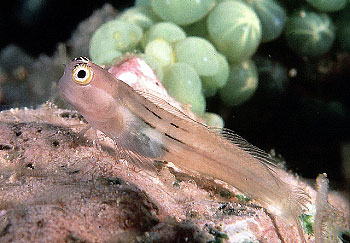 |
Left:
A difference in both size and coloration invoked the
concern as to whether Ecsenius aequalis was actually
two different species. For now, even though individuals
from Osprey Reef and the Great Barrier Reef differ (GBR
individuals are on average 25% larger), they will continue
to share one name. Photo courtesy of John Randall.
|
|
Right:
Originally collected from the Banda Islands, Ecsenius
bandanus has the largest distribution of any Prooculis
member, which really isn't saying much as this entire
group is geographically limited. Photo courtesy of John
Randall.
|
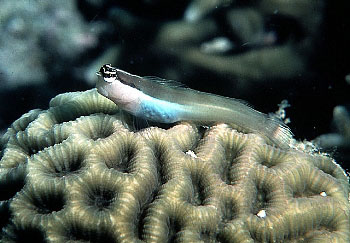 |
Although Ecsenius species are not
aggressive in the wild, small gobies may be at risk from them
if kept in the same aquarium. The risk escalates if this combo
is placed into a smaller aquarium. Ecsenius species
will defend their small patch of reef, and defenseless gobies
will be unable to escape their aggression. Barring large or
aggressive predators, Ecsenius can adapt to an aquarium
with most other fish. Large but non-predator fish such as
surgeonfish, fairy wrasses and angelfish will largely ignore
these blennies. As can be assumed for most small fish, placing
Ecsenius with Groupers, Scorpionfish, or other predators
is unwise and will certainly end with a meal for the predator.
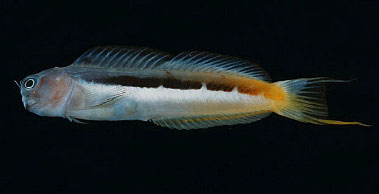 |
The rarest color form of Ecsenius bicolor, the striped
pattern, is seen here. At one time
Ecsenius hawaiiensis was believed to be an endemic
of Hawaiian waters, but increased
collection throughout Hawaiian waters with no further collections
of this fish has led
researchers to believe E. hawaiiensis was actually
E. bicolor. Photo courtesy
of John Randall.
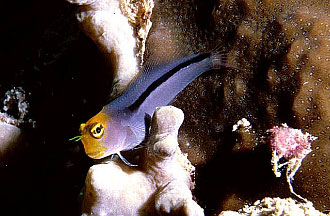 |
Left: The Smoothfin Blenny, Ecsenius frontalis,
has three distinct color forms. The striped or nigrovittatus
form can be seen above, while the frontalis form can
be seen below. The bi-color form, also called albicaudatus,
is absent from the photos given here, but as the name
implies, it has two distinct colors divided in a similiar
fashion to E. bicolor. Photo courtesy of Richard
Field.
|
|
Right: Photo courtesy of Richard Field.
|
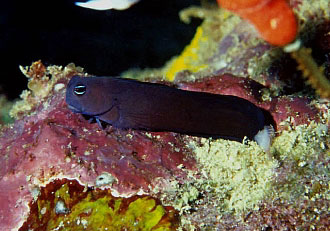 |
Compatibility
chart for Ecsenius species:
|
Fish
|
Will
Co-Exist
|
May Co-Exist
|
Will Not Co-Exist
|
Notes
|
|
Angels, Dwarf
|
X
|
|
|
Good choice.
|
|
Angels, Large
|
X
|
|
|
Good choice.
|
|
Anthias
|
X
|
|
|
Good choice.
|
|
Assessors
|
|
X
|
|
May be harassed by Ecsenius
species.
|
|
Basses
|
X
|
|
|
Good choice.
|
|
Batfish
|
X
|
|
|
Good choice.
|
|
Blennies
|
|
|
X
|
Most blennies will not mix well in
a home aquarium.
|
|
Boxfish
|
X
|
|
|
Good choice.
|
|
Butterflies
|
X
|
|
|
Good choice.
|
|
Cardinals
|
X
|
|
|
Good choice.
|
|
Catfish
|
|
X
|
|
Large adults may try to consume Ecsenius
species.
|
|
Comet
|
X
|
|
|
Good choice.
|
|
Cowfish
|
X
|
|
|
Good choice.
|
|
Damsels
|
X
|
|
|
Good choice.
|
|
Dottybacks
|
X
|
|
|
Good choice.
|
|
Dragonets
|
X
|
|
|
Good choice.
|
|
Drums
|
X
|
|
|
Good choice.
|
|
Eels
|
|
X
|
|
Large adults may try to consume Ecsenius
species.
|
|
Filefish
|
X
|
|
|
Good choice.
|
|
Frogfish
|
|
|
X
|
May consume Ecsenius species.
|
|
Goatfish
|
|
X
|
|
Large adults may try to consume Ecsenius
species.
|
|
Gobies
|
|
X
|
|
May be harassed by Ecsenius
species.
|
|
Grammas
|
X
|
|
|
Good choice.
|
|
Groupers
|
|
|
X
|
May consume Ecsenius species.
|
|
Hamlets
|
X
|
|
|
Good choice.
|
|
Hawkfish
|
X
|
|
|
Good choice.
|
|
Jawfish
|
X
|
|
|
Good choice.
|
|
Lionfish
|
|
|
X
|
May consume Ecsenius species.
|
|
Parrotfish
|
X
|
|
|
Good choice.
|
|
Pineapple Fish
|
X
|
|
|
Good choice.
|
|
Pipefish
|
|
|
X
|
An aquarium dedicated to Pipefishes
is recommended.
|
|
Puffers
|
X
|
|
|
Good choice.
|
|
Rabbitfish
|
X
|
|
|
Good choice.
|
|
Sand Perches
|
X
|
|
|
Good choice.
|
|
Scorpionfish
|
|
|
X
|
May consume Ecsenius species.
|
|
Seahorses
|
|
|
X
|
An aquarium dedicated to Seahorses
is recommended.
|
|
Snappers
|
|
|
X
|
May consume Ecsenius species.
|
|
Soapfishes
|
|
|
X
|
May consume Ecsenius species.
|
|
Soldierfish
|
|
X
|
|
Large adults may try to consume Ecsenius
species.
|
|
Spinecheeks
|
X
|
|
|
Good choice.
|
|
Squirrelfish
|
|
X
|
|
Large adults may try to consume Ecsenius
species.
|
|
Surgeonfish
|
X
|
|
|
Good choice.
|
|
Sweetlips
|
|
|
X
|
May consume Ecsenius species.
|
|
Tilefish
|
X
|
|
|
Good choice.
|
|
Toadfish
|
|
|
X
|
May consume Ecsenius species.
|
|
Triggerfish
|
|
X
|
|
Some species are overly aggressive.
Odonus niger may be an exception.
|
|
Waspfish
|
|
X
|
|
Large adults may try to consume Ecsenius
species.
|
|
Wrasses
|
X
|
|
|
Good choice.
|
Note: While many of the fishes listed
are good tank mates for Ecsenius species, one should
research each fish individually before adding it to the aquarium.
Some of the fish listed above are better left in the ocean
or for advanced aquarists.
|
The dark color variation of E. gravieri is representative
of specimens from the southern Red Sea and the Bay of
Tadjourah. Photo courtesy of Greg Rothschild.
|
Possibly the most attractive species of Ecsenius is
the Red Sea Mimic, E. gravieri.
Photo courtesy of Richard Field (left) and John Randall
(right).
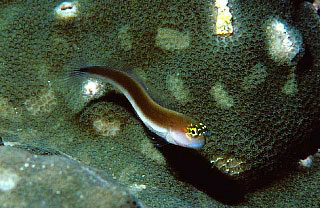 |
Left: The picture shown here for Ecsenius
pulcher shows one of three distinct colorations.
The horizontal striping has on occasion been considered
a mood induced coloration because the horizontal stripes
fade in lieu of the more traditional vertical bi-colored
form when dead. Photo courtesy of Richard Field.
|
|
Right: Ecsenius pulcher, showing a traditional
bi-colored coloration. Photo courtesy of John Randall.
|
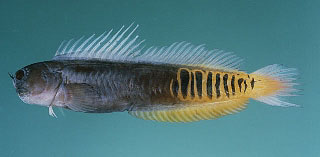 |
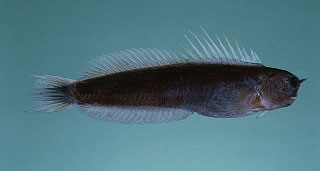 |
Left: Ecsenius pulcher, showing a uniform
dark coloration. Photo courtesy of John Randall.
|
Right: Ecsenius aroni, a resident of the
Red Sea and the Gulf of Aqaba, is a deeper dwelling
species of Ecsenius, regularly occuring deeper
than 100 feet. Photo courtesy of Richard Field. |
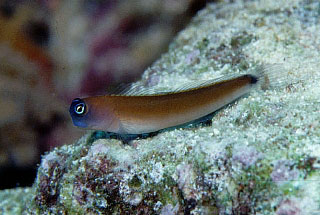 |
Even though these comb-toothed blennies
are not found in the wild without lush coral gardens around
them, they seem to adapt to aquariums without corals without
stressing out. This may, in fact, be the best option, as it
eliminates the concerns of mantle nibbling and coral polyp
feeding. One of the largest concerns, however, is providing
adequate hiding spaces. With or without coral, many small
crevices and look-outs should be provided. These will be very
important, especially upon first introducing the blenny to
the aquarium. Once settled in, the fish will possibly spend
a majority of its time sitting on ledges or on the sand in
plain view.
|
Ecsenius yaeyamaensis standing watch for its
next meal. Photo courtesy of Richard Field.
|
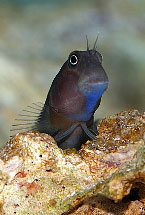 |
|
Photo
courtesy of Greg Rothschild.
|
Once the tankmates and rockwork are under
control, the choice of food should be considered. Many of
these species are herbivorous with a strict diet of microalgae.
If you are choosing a species that relies on algae for a large
portion of its diet, preparations should be made to ensure
microalgae are readily available for it to consume in the
aquarium. One of the best places for this to occur is the
back glass. By simply never cleaning the back glass, most
aquariums will readily grow film algae. By allowing micro
algae to grow on viewable panes of glass the aquarist will
get the opportunity to witness the kiss marks these blennies
leave on the glass when they scrape or comb the algae from
it. Hopefully, as time allows the fish to adjust to aquarium
life it will become accustomed to eating algae from pellets,
flakes, or dried strips sometimes called "nori."
Of course, the larger the selection of algae offered, the
healthier the fish will be. Although some blennies may consume
large amounts of undesirable hair algae, it is unrealistic
to assume that an Ecsenius species will make any kind
of dent in a healthy crop. In fact, it is quite possible the
individual will not consume any hair algae. A single Ecsenius
species, E. midas, is not a strict herbivore and will
actually prefer to consume zooplankton. For those individuals,
mysid shrimp should be considered along with enriched brine
shrimp, flake and pellets, or any food designed for smaller
carnivorous fish. These same fish will, however, appreciate
the occasional vegetable in their diet, so be sure not to
starve them of their veggies entirely.
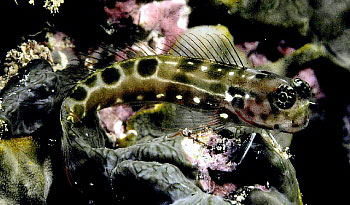 |
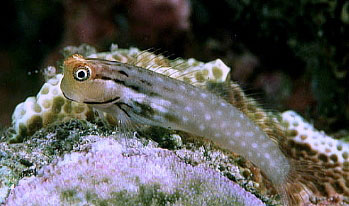 |
Left: From the Latin term "sella,"
meaning "saddle," comes the name of Ecsenius
sellifer, presumably given in reference to the numerous
saddle-like markings along the length of the fish's body.
Right: The color pattern of Ecsenius yaeyamaensis
is nearly identical to E. nalolo, E. minutus,
and the rest of the Yaeyamaensis Group. Photos courtesy of
John Randall.
|
|
|
The namesake of the Prooculis Group, Ecsenius prooculis,
has the same vivid eye coloration as E. collettei,
but instead of spots, like E. collettei, it has
stripes. Photo courtesy of John Randall.
|
Left: Ecsenius portenoyi lended a hand in determining
that Ecsenius species do not live in harems when, on
one particular collection, 114 individuals were taken; 57
were male, and 57 were female. Right: Ecsenius monoculus
are routinely collected from water shallower than most Ecsenius
species. Locating these individuals below 10 feet of depth
is not common. Photos courtesy of John Randall.
Meet the Species
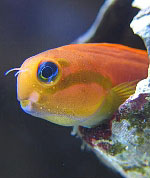 |
|
Photo
courtesy of Ramon (MrSandman).
|
Very few Ecsenius species actually
show up in the aquarium trade with regularity. Ecsenius
bicolor, the Bicolor blenny, is by far the most common
of all members of this genus. Therefore, it should not be
surprising that E. bicolor also has one of the largest
wild distributions of all Ecsenius. Three color variations
are scientifically recognized. The variation most common to
aquarists is that of the bicolor, whose head and usually more
than half the body is uniformly dark, usually brown, while
the rear is pale, usually orange or yellow. Other specimens
are noted to be a solid dark color, and yet the least common
is a striped version which has the pale color running the
length of the bottom side of the fish. Collectors have noted
collecting on average two striped specimens, the least common
color variety, for every 25 bi-colored individuals. No correlation
between sex, maturity, or other social considerations has
ever been linked to the color variations. Like the vast majority
of the species it will thrive only in an aquarium containing
microalgae growth. Although easy to keep, it should be noted
this species has been known to consider clam mantles and coral
polyps as appetizing options on occasion.
A beautiful species and another that can be easily obtained
is the Midas blenny, or Ecsenius midas. This is the
only species whose natural distribution is larger than E.
bicolor's. In fact, the distribution of E. midas
is only slightly smaller than the distribution of the entire
genus itself. Obviously, the wide distribution plays a large
role in this species' availability in the aquarium trade.
The Midas blenny is a planktivore, however, and thus may in
some regards be easier to care for. Getting these fish to
eat from the water column is usually not difficult, and because
they do not scrape algae from the rockwork they are also less
likely to annoy sessile invertebrates. Additionally, much
to the delight of home aquarists, their planktonic nature
dictates the fish will spend a considerable amount of time
hovering in the water column. The color of individuals varies
greatly depending upon the locality. Individuals may range
from bright yellow to orange with any combination thereof.
Additionally, some individuals will have thin stripes which
may vary from black to blue. They are the largest of all Ecsenius,
barely reaching ten centimeters of total length.
Possibly the most sought-after specimen is Ecsenius gravieri,
or the Red Sea Mimic Blenny. As the common name implies, and
as was discussed earlier, this specimen is a Batesian mimic
of the fang blenny Meiacanthus nigrolineatus. Like
any other fish from the Red Sea region, when you can find
one, be prepared to pay handsomely for it. Unfortunately,
their beauty does not inhibit their enjoyment of SPS or clams.
Ecsenius bicolor in the traditional bicolor coloration.
Photos courtesy of Greg Rothschild.
Conclusion
Every aquarist shares a different viewpoint
with regard to the fish care term "reef-safe." No
matter how you personally define it, however, few Ecsenius
species likely fit this definition. Although not all specimens
will nip clam mantles or scrape SPS tissue, enough of them
will that the warning should be heeded. If you must choose
an Ecsenius species to add to a reef aquarium, take
a serious look at Ecsenius midas because it is a planktivore,
and therefore less likely to develop an affinity for sessile
invertebrates. Finally, if you plan to avoid LPS, SPS, and
clams in your aquarium, there is a strong possibility that
any Ecsenius species will be a model citizen for many
years.
|
Although it may not look like it, this is Ecsenius
bicolor. This specimen is of the dark color variety
and does not exhibit the typical two-color contrast
that is typical of E. bicolor. Photo courtesy
of Greg Rothschild.
|
Left: Ecsenius trilineatus is noted to be the
smallest member of the Ecsenius genus. Both males and
females have measured a maximum of 27 mm. Interestingly, this
also indicates that size is not a sexual dimorphism as it
is in other species of this genus. Right: Four of the
five representatives of the Prooculis Group are located within
the near vicity of New Guinea. Not to break the mold, Ecsenius
taeniatus is endemic to New Guinea, found only around
the Goodenough Island. Photos courtesy of John Randall.
Photo courtesy of Greg Rothschild.
|

